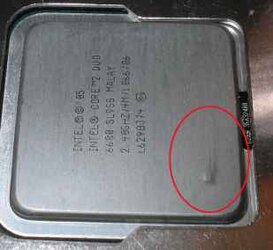This is bizarre: I installed my retail E6600 with stock fan, having removed the original paste and replaced with Arctic Silver 5, and since everything was working, I did a safe overclock: 333 FSB * 9 = 2.97 GHz, Mem 2:3 Corsair 8500C5 5-5-5-15 and it boots stable at the stock CPU voltage.
I then tried the usual tests (Intel TAT, Prime, etc...) and was getting 37-40 degrees on idle and over 70 degrees on Prime/ortho stress using CoreTemp, SnM, and TAT for temp measurements. I tried replacing the Arctic Silver twice following their recommended procedure, but this had no effect, and from the spread it looks like the paste was well distributed. However, while at worst the heatsink was slightly warm to touch, it was never very warm or even close to hot.
So I went back to the BIOS, set EVERYTHING back to default settings, rebooted and found that I was getting exactly the same thermal behavior even at default settings.
I've read many discussions on the Conroe thermals, and even refered to the Intel technical docs and the max temp at the max 65 Watts should top off at 60.1 degrees C.
When I opened the retail box, I did notice that the top of the CPU has some signs of use: slight glossy areas and one clear glossy area you can clearly see in the picture. I assumed this may have been from testing at the factory. I carefully inspected the box (I always do), and there seems to be no evidence of tampering. If there was, it's definitely a pro job.
On the other hand, maybe there's something wrong with the thermal reporting. If three different programs are reporting the same temps, if there is a problem, it could only be at the sensor, or its supporting circuitry. Other than trying the CPU on another mobo, or an older BIOS, I don't see how I could test for that.
So either I have a bum original chip, the thermal reporting is off, or this chip was abused and sold to me as new. I'll go back to the retailer and what he has to say.
Anyone have any ideas on this?
Breeze
I then tried the usual tests (Intel TAT, Prime, etc...) and was getting 37-40 degrees on idle and over 70 degrees on Prime/ortho stress using CoreTemp, SnM, and TAT for temp measurements. I tried replacing the Arctic Silver twice following their recommended procedure, but this had no effect, and from the spread it looks like the paste was well distributed. However, while at worst the heatsink was slightly warm to touch, it was never very warm or even close to hot.
So I went back to the BIOS, set EVERYTHING back to default settings, rebooted and found that I was getting exactly the same thermal behavior even at default settings.
I've read many discussions on the Conroe thermals, and even refered to the Intel technical docs and the max temp at the max 65 Watts should top off at 60.1 degrees C.
When I opened the retail box, I did notice that the top of the CPU has some signs of use: slight glossy areas and one clear glossy area you can clearly see in the picture. I assumed this may have been from testing at the factory. I carefully inspected the box (I always do), and there seems to be no evidence of tampering. If there was, it's definitely a pro job.
On the other hand, maybe there's something wrong with the thermal reporting. If three different programs are reporting the same temps, if there is a problem, it could only be at the sensor, or its supporting circuitry. Other than trying the CPU on another mobo, or an older BIOS, I don't see how I could test for that.
So either I have a bum original chip, the thermal reporting is off, or this chip was abused and sold to me as new. I'll go back to the retailer and what he has to say.
Anyone have any ideas on this?
Breeze
